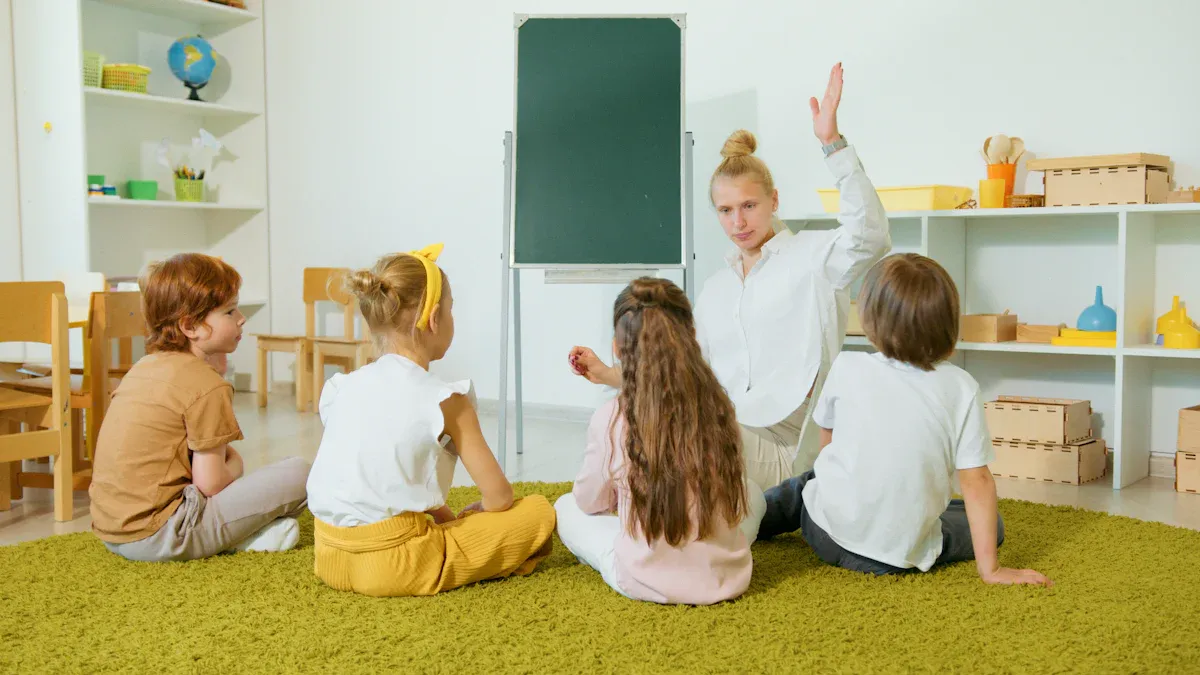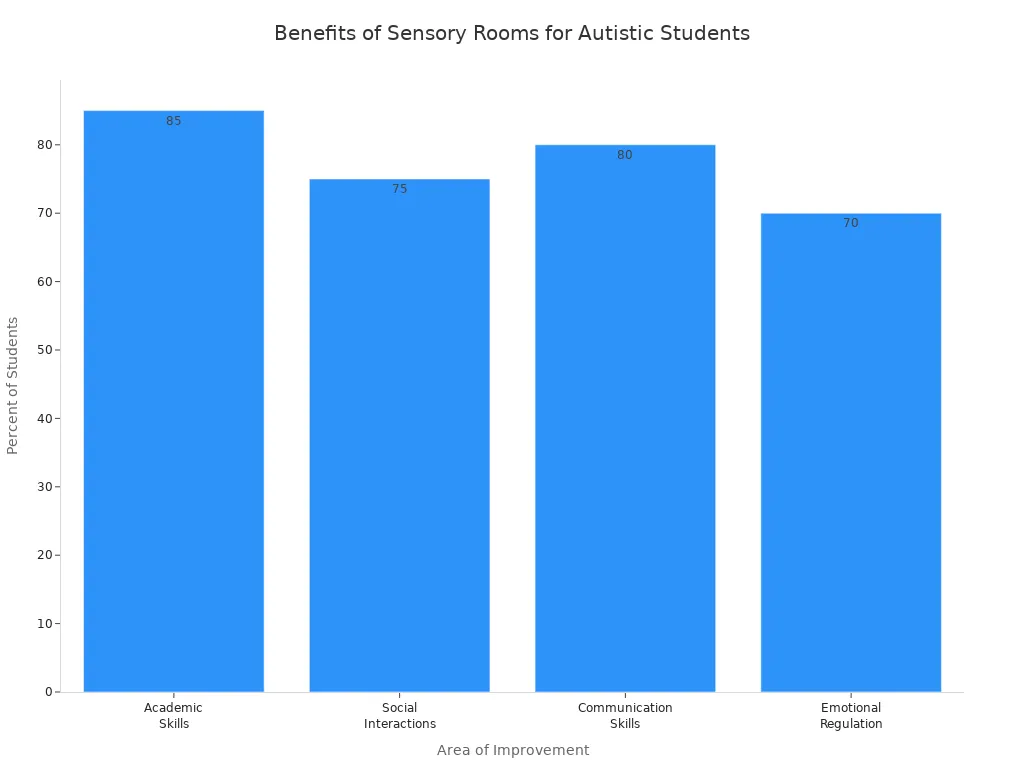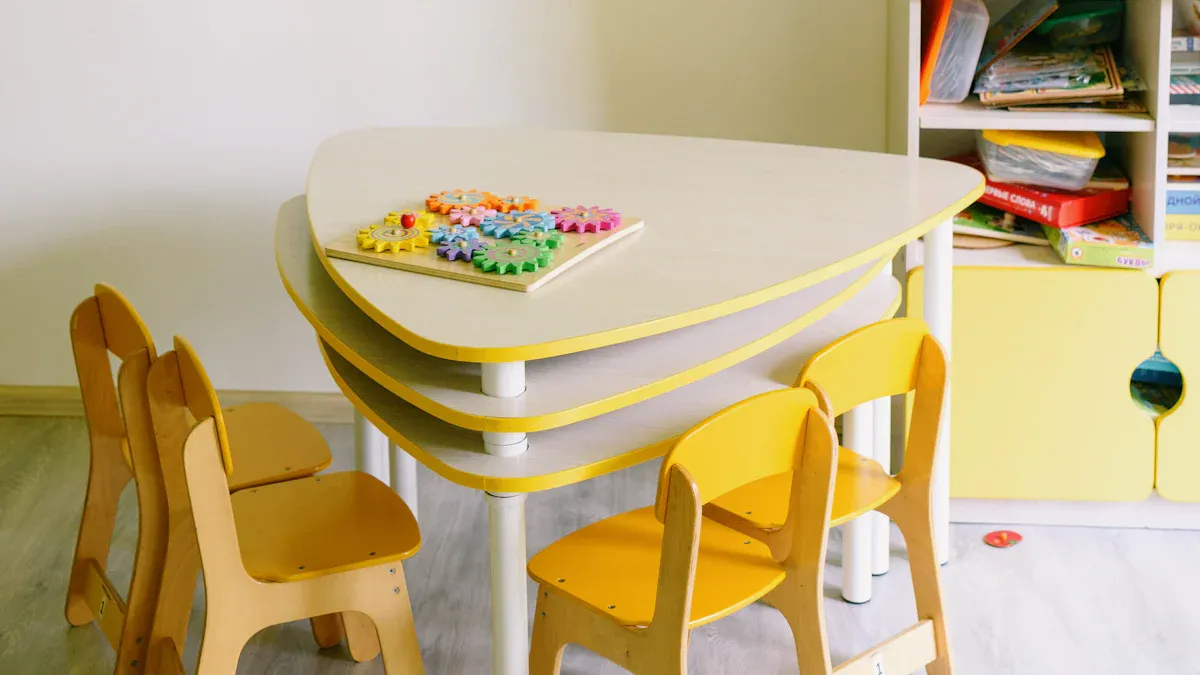Best Practices for ASD Sensory Rooms in Schools

Imagine a student who gets stressed by loud sounds and bright lights. You can help this student by using best practices for an asd sensory room. Studies show that multisensory spaces help lower tough behaviors and boost focus for autistic students. You should pick careful designs, make clear rules, and team up with others to fit each student's likes. Think about how your sensory room helps students right now.
Key Takeaways
Make sensory rooms with calm things like soft lights, quiet walls, and things you can touch. This helps students feel safe and calm.
Let students help plan the room by asking what tools and activities they like. Their ideas make the sensory room work better.
Set clear rules and a schedule for using sensory rooms. This keeps everyone safe and helps students know what will happen.
Change sensory rooms often by listening to what students need and say. This makes sure the room stays helpful for everyone.
Work with teachers, therapists, and families to build a strong support team. This teamwork makes sensory rooms work even better.
Effective Sensory Rooms

Key Features
You can make sensory rooms work well by adding things that help autistic students feel safe and calm. These rooms usually have soft bean bags, weighted blankets, and pillows you can touch. You can also put in interactive media walls, fidget walls, and sensory toys. This gives students more choices. Lights that you can change and soundproofing help control the room. Soft lights and quiet sounds help students relax and make the room feel nice.
Tip: Ask your students what makes them feel good. Their answers can help you make the room better.
A good sensory room lets students move around or rest. You can make quiet spots with soft mats or tents. This setup lets students pick if they want to be near others or alone. When you change the room for what students need, it helps everyone more.
Student Benefits
When you use good sensory rooms, you help students handle too much noise or light. These rooms have soft things to touch, gentle lights, and quiet sounds. Studies show students who use sensory rooms feel less stress and can control their feelings better. They pay more attention in class and have fewer hard behaviors.
Many autistic students feel stressed in busy classrooms. Sensory rooms give them a break and help them get ready to learn again.
Schools see good changes after they add sensory rooms. Look at the table below to see how students got better:
Area of Improvement | Percentage of Students Reporting Improvement |
|---|---|
Academic Skills | 85% |
Social Interactions | 75% |
Communication Skills | 80% |
Emotional Regulation | 70% |

Long-term studies show students who use sensory rooms with occupational therapy get better at talking, moving, and behaving over ten years. You can help students by listening to what they need and working with them to make learning plans.
Many students feel overwhelmed in normal classrooms.
They need help to handle sensory problems.
Teachers who listen and work with students see better results.
ASD Sensory Room Design

Sensory Interventions
You can help students by picking the right sensory tools. In an asd sensory room, offer many different activities and tools. Weighted blankets, fidget toys, and bean bags help students calm down. These ideas help students feel less anxious and avoid getting overwhelmed. Using things like exercise balls and tactile pillows helps students who need proprioceptive input.
Tip: Ask students which tools help them feel calm. Change your sensory room classroom based on what they say.
Sensory rooms let students control their space. Adding calming activities and tools helps students learn better and join class activities. Update your sensory room classroom often to fit what students need.
Lighting and Sound
Lighting and sound affect how students feel in an asd sensory room. Use lights you can adjust to stop glare and flicker. Soft, dim lights or natural light help students relax. Soundproofing, like carpets and curtains, keeps out loud noises and makes the room calm.
You can add gentle music or nature sounds to help students feel safe.
Do not use harsh fluorescent lights in your sensory room classroom.
A sensory room classroom with good lighting and sound helps students control their senses. Use equipment like speakers and fans to make the room peaceful.
Tactile and Visual Elements
Tactile and visual elements are important in an asd sensory room. Add weighted blankets, textured pillows, and fidget walls. These tools help students feel comforted and calm.
Calming colors like soft blues and greens make the room feel safe. Use light projectors, bubble tubes, and interactive media walls for a soothing space.
Pick sensory room ideas that help students relax. Ask students which textures and colors they like best. This helps you make your sensory room classroom fit each student.
Quiet Zones and Layout
Design your asd sensory room with quiet zones and flexible layouts. Make cozy spaces with soft mats, tents, or bean bags. These spots let students take breaks and calm down.
Arrange your sensory room classroom so students can move easily and feel safe.
Keep sensory tools and toys where students can reach them.
Here is a table showing what makes quiet zones work well:
Feature | Description |
|---|---|
Lighting | Use soft, adjustable lighting to make the room soothing. Avoid harsh fluorescent lights. |
Sound Control | Soundproofing and calming sounds lower noise and help students relax. |
Textures and Materials | Soft carpets and tactile objects make the room cozy and help students feel better. |
Balance spaces for group activities and quiet time. Change your sensory room classroom layout often based on what students say. This keeps your asd sensory room helpful and welcoming.
Note: You can set up a sensory room classroom with any budget. A simple setup with paint, adjustable lights, and comfy seats can cost about $2,500. If you have more money, you can add things like interactive projectors and haptic furniture.
Sensory Room Guidelines
Usage Protocols
You need clear rules to keep the sensory room safe. These rules help everyone know what to do. Plan sensory time in the daily schedule. This helps students feel calm and know what will happen. Use visual supports like schedules and social stories. These show students each step. Sensory kits can help guide activities.
Here is a table with important sensory room rules:
Protocol/Guideline | Description |
|---|---|
Adult Supervision | An adult must always be there for safety. |
Structured Usage | Put sensory time into daily routines. |
Desired Outcomes | Decide if the room is for calming or alerting. |
Equipment Tracking | Check and write down how equipment is used. |
Regular Cleaning | Clean things often to stop germs from spreading. |
Incident Documentation | Write down any problems that happen in the room. |
Staff Training | Teach staff how to use sensory tools and equipment. |
Supervision | Watch students all the time for safety. |
Use daily records to track changes in behavior and feelings. Weekly or monthly reports help you see patterns and progress. Work with parents and teachers to share ideas and keep routines the same.
Tip: Use pictures and clear routines to help students feel safe and know what comes next.
Supervision and Safety
You must follow strict rules for watching students in the sensory room. Watching students closely keeps them safe. Staff need to pay attention at all times. Set up the room so you can see everywhere. This helps stop accidents and lets you act fast if needed.
Always count all students, especially during changes.
Younger kids and those with special needs need close watching.
Keep play areas open and easy to see.
Staff need training to follow safety rules. Programs like Sensory Friendly 101 teach how to stop sensory overload and use tools. You can learn from online lessons, workshops, and community helpers. Working with healthcare workers and families helps you know each student's needs.
Note: Watching students and following safety rules keeps everyone safe and helps them feel secure in the sensory room.
Who Benefits
Sensory room rules help many students, not just those with autism. You can help students with cerebral palsy, Down syndrome, and other disorders. Students who have trouble talking, moving, or making friends also benefit from sensory rooms.
Students with sensory problems use the room to calm down or get ready to learn.
Those who need help with feelings find comfort in sensory-friendly spaces.
Students with physical disabilities use tools to help with movement and balance.
Schools use checklists and other ways to see if sensory room rules work. Long-term studies show students get better at social skills, talking, and handling senses when they use sensory rooms with therapy.
Here is a table showing how schools check if sensory room rules work:
Method of Evaluation | Description |
|---|---|
Standardized Assessments | Use checklists to track changes in social skills and senses. |
Longitudinal Studies | Compare progress over years with sensory room and therapy. |
Program Evaluations | Collect data before and after to see if students join in more. |
Sensory room rules help you make a safe, organized, and friendly space for all students. You can use pictures, routines, and sensory tools to help each student.
Integration and Individualization
Scheduling and Access
You can help everyone by planning when students use sensory areas. Start with a small calming spot in the classroom. Put bean bags and sensory bins in a corner. You do not need a whole room to start. Let all students take sensory breaks, not just autistic students. This makes sensory breaks normal for everyone. It helps students feel included and want to join in. Teach your class why sensory accommodations are helpful. Encourage students to manage their own feelings. Let students help pick items for the sensory areas in classrooms. This gives them a sense of ownership. It also helps them learn to handle overload and dysregulation.
Here are ways schools plan scheduling and access:
Begin with a calming spot for kids in the classroom.
Make sensory breaks normal for everyone.
Work with students to pick items for sensory areas in classrooms.
You can also make calm-down spots and quiet zones in the classroom. These spaces let neurodivergent students take breaks when they feel overwhelmed. You help students by giving them a safe, supervised place to go when needed.
Evidence Type | Description |
|---|---|
Make a special spot in the classroom for students to go when they feel overwhelmed. | |
Sensory Breaks | Let students take breaks in sensory areas in classrooms to handle overload. |
Adapting to Needs
You help students best when you change sensory areas in classrooms to fit their needs. Customizing lets you update the room as students’ needs change. Ask students what works and update equipment often. Check safety every month and review how things are going. Hybrid sensory rooms have both active and calm spaces. Students can move or rest as they need. Watch and listen to each student’s likes and dislikes. Add favorite items or comforting things to the sensory areas in classrooms. Be flexible with the setup and check if sensory tools are working.
Strategy | Description |
|---|---|
Change sensory areas in classrooms for each student’s needs. | |
User Feedback | Use what students say to make changes for overload and dysregulation. |
Professional Consultation | Ask experts for help with complex needs in sensory areas in classrooms. |
Regular Evaluation | Check safety and update equipment every month in sensory areas in classrooms. |
Get feedback from students to see what works.
Do safety checks every month.
Update equipment when needed.
Check what students like often.
You help students focus and stay calm by changing sensory areas in classrooms. You can make quiet spots and calm-down areas for overload and dysregulation. This helps students who need a calming space for kids and supports self-regulation.
Collaboration and IEPs
You get better results by working with teachers, therapists, and families. Working together helps you support students in sensory areas in classrooms. Set clear roles and talk often. Give regular updates and hold workshops for families. Occupational therapists and teachers work together to add sensory strategies to class routines. Teachers and caregivers give feedback to keep sensory areas in classrooms helpful for overload and dysregulation.
Source | Evidence |
|---|---|
The Role of Collaboration Between Therapists and Educators in Autism | Working together with clear roles and good communication helps students. |
Collaboration Is Key in Special Education | Talking openly and giving updates helps families. |
The Importance of Sensory-Friendly Strategies in Occupational Therapy | Therapists and teachers working together helps use sensory strategies. |
Top Ways Schools Evaluate Effectiveness of Their Sensory Rooms | Teachers and caregivers giving feedback keeps sensory areas in classrooms helpful. |
You can add sensory areas in classrooms to IEPs for each student. This helps support students and self-regulation. You make sure sensory areas in classrooms help with overload and dysregulation for everyone.
You can make a good ASD sensory room by thinking about safety, comfort, and flexibility. Use soft floors and safe furniture. Make sure students can walk around easily. Work with families, teachers, and experts to get ideas and share supplies.
Step | Description |
|---|---|
Design Environment | Create a safe space that fits all sensory needs. |
Balance Proximity and Separation | Put rooms close to classrooms but keep them quiet. |
Prioritize Sound Absorption | Use things that help make the room quieter. |
Utilize Adaptive Lighting | Add lights you can change to fit needs. |
Emphasize Tactile Elements | Use weighted blankets and bean bags for comfort. |
Checking the room often helps you change it when students need something new.
Keep asking students what they need and update your sensory room. When you do this, every child feels welcome and ready to learn.
FAQ
What is a sensory room and how does it help in classrooms?
A sensory room is a special space in classrooms. It has tools and activities for students who need help with their senses. Students can calm down or focus better in this room. When you add sensory rooms, students learn and join in more.
Who can use sensory rooms in classrooms?
All students in classrooms can use sensory rooms. Students with autism or sensory challenges get the most help. Letting everyone use sensory spaces makes classrooms more welcoming.
How do you set up sensory rooms for sensory processing in classrooms?
Start by putting soft chairs and things to touch in the room. Use lights you can change and calming colors. Add soundproofing to keep the room quiet. Ask students what helps them feel better. Change the room often to fit what students need.
Why is inclusion important in classrooms with sensory rooms?
Inclusion means everyone can use the sensory room. Teach students about sensory needs and respecting others. This helps all students feel welcome and supported in class.
How do you know if sensory rooms improve sensory processing in classrooms?
Watch how students act and focus in class. Use checklists and ask students for feedback. You will see fewer problems with sensory processing. More students will feel safe and ready to learn.
See Also
Essential Elements for Effective ASD Sensory Spaces in Schools
Best Practices for Creating Functional Sensory Rooms in Schools
Innovative Sensory Room Concepts That Are Proven to Work
Comprehensive Instructions for Creating an ASD Sensory Room at Home
Thorough Guide for Establishing Sensory Rooms at Home and Schools
